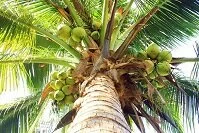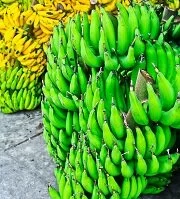Wildlife

Coconut tree
As an island nation the number of native plants and animals in Tuvalu are severely limited. The native land life is almost non-existent and the native plant life was also very limited; only the migrating birds and sea life had any significant presence in historic Tuvalu. Most of what is found on the islands today was introduced in pre-historic times by the migrating people, birds, winds, and ocean currents.
As an island nation that rose from the sea floor there were no native mammals in Tuvalu, although a few bat species arrived thousands of years ago. Other than this, no land mammals existed on Tuvalu until possibly the arrival of the earliest people, who likely came from the region of New Guinea and may have brought with them rats. Since, or at this same time dogs and mice have also been introduced.
The other historic mammals connected with Tuvalu are in the sea as dolphins and whales are present in the waters surrounding the islands. These waters are also filled with thousands of fish, shellfish, and other forms of sea life. In these waters you can find surgeonfish, clownfish, sailfish, puffer fish, butterfly fish, grouper, barracuda, tuna, mackerel, marlin, mahi-mahi, shrimp, krill, crab, seahorses, manta rays, sharks, jellyfish, starfish, sea urchins, and coral among many others.
The water and the land have attracted more than just fish though, they have also attracted numerous birds, including many that feed off the animals in the sea. The bird life in Tuvalu includes doves, owls, passerines, scrub fowls, heron, terns, pigeons, and cuckoos among others.

Bananas
Like the mammalian life, the reptilian and amphibious life is fairly limited. The most common of these animals are those adapted to the water and swimming as sea turtles can be found in the nearby waters and the green turtle even nests on beaches near Funafuti. Land species have again made their way to the islands in numerous methods and today lizards are among the most common of these animals.
The insect and other small animal life is fairly diverse as many insects can fly or float and have made their way to Tuvalu. These animals include butterflies, moths, bees, ants, flies, snails, spiders, and worms among others.
Like the animal life, the plant life is also very limited. It is doubtful any plants originated in the country itself other than a very limited number of local plants. However the winds and water currents have taken seeds to the islands and in other cases birds have transported seeds to the islands. Because of this many of the most common plants on the islands today are native to the nearby islands of New Guinea and those further west. Plants from these nearby islands that now thrive in the country include coconuts, taro, breadfruit, bananas, yams, arrowroot, lemons, and sugarcane among others.
There is also a substantial presence of other trees and plants, including orchids, hibiscus, eucalyptus, frangipani, ferns, mosses, mahogany trees, mangrove trees, and pandanus trees.